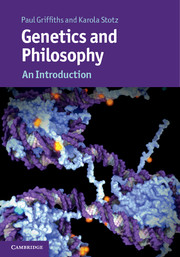3 - The material gene
Published online by Cambridge University Press: 05 April 2013
Summary
Introduction
In this chapter we describe the elucidation of the basic structure and function of DNA. This represented the successful conclusion of the search for the gene as a material unit of heredity. However, the causal role of the gene as it had been envisaged in classical genetics was very substantially revised in order to fit what had been discovered about the material basis of heredity. So the result of the molecular revolution in genetics was not that a previously defined causal role (the Mendelian gene) was filled by a newly discovered material occupant (the molecular gene). The molecular gene had a new role of its own, very different from that of the Mendelian gene. This explains some of the difficulties encountered by philosophers who have tried to explain how the Mendelian gene was reduced to molecular biology. Although the new, molecular identity of the gene was now its dominant identity, the old instrumental identity did not simply go away. The original role of the Mendelian gene continues to define the gene in certain areas of biological research: namely, those intellectually continuous with classical genetic analysis. We will show later in the chapter that it is sometimes necessary to think of genes as both Mendelian alleles and molecular genes, even when those two identities do not converge on the same pieces of DNA. The Mendelian gene turned out to be grounded in DNA, but the development of genetics has left us with more than one scientifically productive way of thinking about DNA and the genes it contains.
A major theme of this chapter is the emergence of ‘informational specificity’ as the key property of the molecular gene. The search for the molecular gene was the search for the source of biological specificity – the ability of biomolecules to catalyse very specific chemical reactions. We describe how specificity was transformed from a physical concept based on stereochemistry – the three-dimensional shape of molecules – to an informational concept based on the linear correspondence between molecules, most famously in the case of the genetic code.
- Type
- Chapter
- Information
- Genetics and PhilosophyAn Introduction, pp. 33 - 65Publisher: Cambridge University PressPrint publication year: 2013

